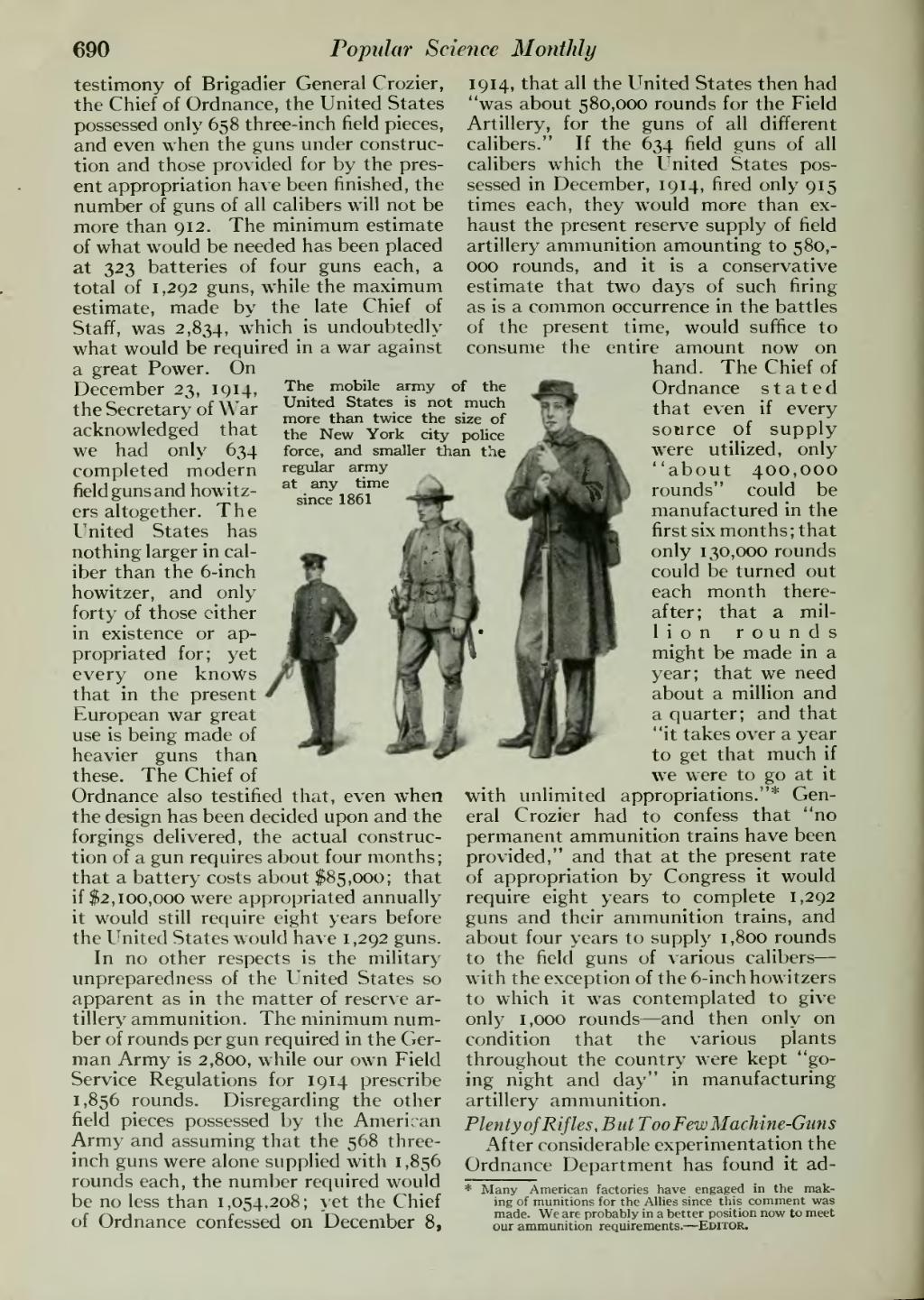690
��Popular Science Monthly
��The mobile army of the United States is not much more than twice the size of the New York city poUce force, and smaller than the regular army at any time since 1861
��testimony of Brigadier General Crozier, the Chief of Ordnance, the United States possessed only 658 three-inch field pieces, and even when the guns under construc- tion and those provided for by the pres- ent appropriation have been finished, the number of guns of all calibers will not be more than 912. The minimum estimate of what would be needed has been placed at 323 batteries of four guns each, a total of 1,292 guns, while the maximum estimate, made by the late Chief of Staff, was 2,834, which is undoubtedly what would be required in a war against a great Power. On December 23, 1914, the Secretary of War acknowledged that we had only 634 completed modern field guns and howitz- ers altogether. The United States has nothing larger in cal- iber than the 6-inch howitzer, and only forty of those cither in existence or ap- propriated for; yet every one knows that in the present European war great use is being made of heavier guns than these. The Chief of
Ordnance also testified that, even when the design has been decided upon and the forgings delivered, the actual construc- tion of a gun requires about four months; that a battery costs about $85,000; that if $2,100,000 were appropriated annually it would still require eight years before the United States would have 1,292 guns. In no other respects is the military unpreparedness of the United States so apparent as in the matter of reserve ar- tillery ammunition. The minimum num- ber of rounds per gun required in the Ger- man Army is 2,800, while our own Field Service Regulations for 1914 prescribe 1,856 rounds. Disregarding the other field pieces possessed by the American Army and assuming that the 568 three- inch guns were alone supplied with 1,856 rounds each, the number required would be no less than 1,054,208; yet the Chief of Ordnance confessed on December 8,
���1 914, that all the United States then had "was about 580,000 rounds for the Field Artillery, for the guns of all different calibers." If the 634 field guns of all calibers which the United States pos- sessed in December, 1914, fired only 915 times each, they would more than ex- haust the present reserve supply of field artillery ammunition amounting to 580,- 000 rounds, and it is a conservative estimate that two days of such firing as is a common occurrence in the battles of the present time, would suffice to consume the entire amount now on hand. The Chief of Ordnance stated that even if every sottrce of supply were utilized, only "about 400,000 rounds" could be manufactured in the first six months ; that only 130,000 rounds could be turned out each month there- after; that a mil- lion rounds might be made in a year; that we need about a million and a quarter; and that "it takes over a year to get that much if w^e were to go at it with unlimited appropriations."* Gen- eral Crozier had to confess that "no permanent ammunition trains have been provided," and that at the present rate of appropriation by Congress it would require eight years to complete 1,292 guns and their ammunition trains, and about four years to supply 1,800 rounds to the field guns of various calibers — with the exception of the 6-inch howitzers to which it was contemplated to give only 1,000 rounds — and then only on condition that the various plants throughout the country were kept "go- ing night and day" in manufacturing artillery ammunition. Plenty of Rifles , But Too FewMachine-Gims After considerable experimentation the Ordnance Department has found it ad-
- Many American factories have engaged in the mak-
ing of munitions for the Allies since this comment was made. We are probably in a better position now to meet our ammunition requirements. — Editor.
�� �
